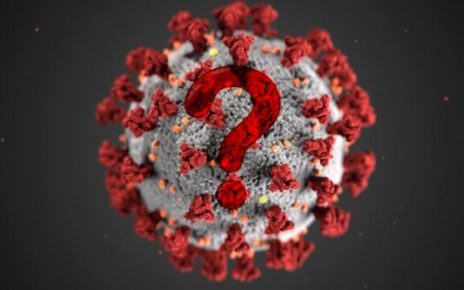Technology developed by the Pentagon’s controversial research branch is getting a huge boost amid the current coronavirus crisis, with little attention going to the agency’s ulterior motives for developing said technologies, their potential for weaponization or their unintended consequences.
In January, well before the coronavirus (Covid-19) crisis would result in lockdowns, quarantines and economic devastation in the United States and beyond, the U.S. intelligence community and the Pentagon were working with the National Security Council to create still-classified plans to respond to an imminent pandemic. It has since been alleged that the intelligence and military intelligence communities knew about a likely pandemic in the United States as early as last November, and potentially even before then.
Given this foreknowledge and the numerous simulations conducted in the United States last year regarding global viral pandemic outbreaks, at least six of varying scope and size, it has often been asked – Why did the government not act or prepare if an imminent global pandemic and the shortcomings of any response to such an event were known? Though the answer to this question has frequently been written off as mere “incompetence” in mainstream media circles, it is worth entertaining the possibility that a crisis was allowed to unfold.
Why would the intelligence community or another faction of the U.S. government knowingly allow a crisis such as this to occur? The answer is clear if one looks at history, as times of crisis have often been used by the U.S. government to implement policies that would normally be rejected by the American public, ranging from censorship of the press to mass surveillance networks. Though the government response to the September 11 attacks, like the Patriot Act, may be the most accessible example to many Americans, U.S. government efforts to limit the flow of “dangerous” journalism and surveil the population go back to as early as the First World War. Many of these policies, whether the Patriot Act after 9/11 or WWI-era civilian “spy” networks, did little if anything to protect the homeland, but instead led to increased surveillance and control that persisted long after the crisis that spurred them had ended.
Using this history as a lens, it is possible to look at the current coronavirus crisis to see how the long-standing agendas of ever-expanding mass surveillance and media censorship are again getting a dramatic boost thanks to the chaos unleashed by the coronavirus pandemic. Yet, this crisis is unique because it also has given a boost to a newer yet complimentary agenda that — if fulfilled – would render most, if not all, other government efforts at controlling and subduing their populations obsolete.
DARPA Dystopia
For years, the Pentagon’s Defense Advanced Research Projects Agency (DARPA) has remained largely out of sight and out of mind for most Americans, as their research projects are rarely covered by the mainstream media and, when they are, their projects are often praised as “bringing science fiction movies to life.” However, there have been recent events that have marred DARPA’s often positive portrayal by media outlets, which paint the agency as a beacon of scientific “progress” that has “changed the world” for the better.
For instance, in 2018, a group of European scientists accused the DARPA’s “Insect Allies” program of actually being a dystopian bioweapons program that would see insects introduce genetically modified viruses into plants to attack and devastate a targeted nation’s food supply. DARPA, of course, maintained that its intent to use these insects to genetically modify plants was instead about “protecting” the food supply. Regardless of DARPA’s assertions that it is merely a “defensive” program, it should be clear to readers that such a technology could easily be used either way, depending on the wielder.
Though DARPA’s futuristic weapons of war often get the most attention from media, the agency has long standing interests in tinkering with, not just the biology of plants, but of humans. DARPA, which is funded to the tune of approximately $3 billion a year, has various avenues through which it pursues these ambitions, with many of those now under the purview of the agency’s “Biological Technologies Office” (BTO), created in 2014. As of late, some of DARPA’s human biology and biotech projects at its BTO have been getting a massive PR boost thanks to the current coronavirus crisis, with recent reports even claiming that the agency “might have created the best hopes for stopping Covid-19.”
Most of these technologies garnering positive media coverage thanks to Covid-19 were developed several years ago. They include the DARPA-funded platforms used to produce DNA and RNA vaccines, classes of vaccine that has never been approved for human use in the U.S. and involve injecting foreign genetic material into the human body. Notably, it is this very class of vaccine, now being produced by DARPA-partnered companies, that billionaire and global health “philanthropist” Bill Gates recently asserted has him “most excited” relative to other Covid-19 vaccine candidates. Yet, key aspects regarding these vaccines and other DARPA “healthcare” initiatives have been left out of these recent positive reports, likely because they provide a window into what is arguably the agency’s darkest agenda.
“In Vivo Nanoplatforms”
In 2006, DARPA announced its Predicting Health and Disease (PHD) program, which sought to determine “whether an individual will develop an infectious disease prior to the onset of symptoms.” The PHD program planned to accomplish this by “identifying changes in the baseline state of human health through frequent surveillance” with a specific focus on “viral, upper respiratory pathogens.”
Three years later, in 2010, DARPA-funded researchers at Duke University created the foundation for this tool, which would use the genetic analysis of blood samples to determine if someone is infected with a virus before they show symptoms. Reports at the time claimed that these “preemptive diagnoses” would be transmitted to “a national, web-based influenza map” available via smartphone.
Following the creation of DARPA’s BTO in 2014, this particular program gave rise to the “In Vivo Nanoplatforms (IVN)” program. The diagnostics branch of that program, abbreviated as IVN:Dx, “investigates technologies that incorporate implantable nanoplatforms composed of bio-compatible, nontoxic materials; in vivo sensing of small and large molecules of biological interest; multiplexed detection of analytes at clinically relevant concentrations; and external interrogation of the nanoplatforms without using implanted electronics for communication.” Past reports on the program describe it as developing “classes of nanoparticles to sense and treat illness, disease, and infection on the inside. The tech involves implantable nanoparticles which sense specific molecules of biological interest.”
DARPA’s IVN program has since helped to finance and produce “soft, flexible hydrogels that are injected just beneath the skin to perform [health] monitoring and that sync to a smartphone app to give the use immediate health insights,” a product currently marketed and created by the DARPA-funded and National Institutes of Health (NIH)-funded company Profusa. Profusa, which has received millions upon millions from DARPA in recent years, asserts that the information generated by their injectable biosensor would be “securely shared” and accessible to “individuals, physicians and public health practitioners.” However, the current push for a national “contact tracing” system based on citizens’ private health data is likely to expand that data sharing, conveniently fitting with DARPA’s years-old goal of creating a national, web-based database of preemptive diagnoses.
Profusa is also backed by Google, which is intimately involved in these new mass surveillance “contact tracing” initiatives, and counts former Senate majority leader William Frist among its board members. They are also partnered with the National Institutes of Health (NIH). The company also has considerable overlap with the diagnostic company Cepheid, which recently won FDA approval for its rapid coronavirus test and was previously awarded lucrative government contracts to detect anthrax in the U.S. postal system. As of this past March, Profusa again won DARPA funding to determine if their injectable biosensors can predict future pandemics, including the now widely predicted “second wave” of Covid-19, and detect those infected up to three weeks before they would otherwise show symptoms. The company expects to have its biosensors FDA licensed for this purpose by early next year, about the same time a coronavirus vaccine is expected to be available to the general public.
“Living Foundries”
Another long-standing DARPA program, now overseen by BTO, is known as “Living Foundries.” According to DARPA’s website, Living Foundries “aims to enable adaptable, scalable, and on-demand production of [synthetic] molecules by programming the fundamental metabolic processes of biological systems to generate a vast number of complex molecules that are not otherwise accessible. Through Living Foundries, DARPA is transforming synthetic biomanufacturing into a predictable engineering practice supportive of a broad range of national security objectives.”
The types of research this “Living Foundries” program supports involves the creation of “artificial life” including the creation of artificial genetic material, including artificial chromosomes, the creation of “entirely new organisms,” and using artificial genetic material to “add new capacities” to human beings (i.e. genetically modifying humans through the insertion of synthetically-created genetic material).
The latter is of particular concern (though all are honestly concerning), as DARPA also has a project called “Advanced Tools for Mammalian Genome Engineering,” which – despite having “mammalian” in the name – is focused specifically on improving “the utility of Human Artificial Chromosomes (HACs),” which DARPA describes as a “fundamental tool in the development of advanced therapeutics, vaccines, and cellular diagnostics.” Though research papers often focus on HACs as a revolutionary medical advancement, they are also frequently promoted as a means of “enhancing” humans by imbuing them with non-natural characteristics, including halting aging or improving cognition.
DARPA is known to be involved in research where these methods are used to create “super soldiers” that no longer require sleep or regular meals, among other augmented “features,” and has another program about creating “metabolically dominant” fighters. Reports on these programs also discuss the other, very disconcerting use of these same technologies, “genetic weapons” that would “subvert DNA” and “undermine people’s minds and bodies.”
Another potential application being actively investigated by DARPA is its BioDesign program, which is examining the creation of synthetic organisms that are created to be immortal and programmed with a “kill switch” allowing a synthetic, yet organic organism to be “turned off” at any time. This has led some to speculate such research could open the doors to the creation of “human replicants” used for fighting wars and other tasks, such as those that appear in the science fiction film Bladerunner.
However, these genetic “kill switches” could also be inserted into actual humans through artificial chromosomes, which – just as they have the potential to extend life – also have the potential to cut it short. Notably, it was revealed in 2017 that DARPA had invested $100 million in “gene drive” research, which is involves the use of genetic modification to wipe out entire populations, explaining why it it often referred to as a “genetic extinction” technology.
In addition, other DARPA experiments involve the use of genetically modified viruses that insert genetic material into human cells, specifically neurons in the brain, in order to “tweak” human brain chemistry. In one example, DARPA-funded research has altered human brain cells to produce two new proteins, the first allowing neural activity to be easily detected by external devices and the second allowing “magnetic nanoparticles” to “induce an image or sound in the patient’s mind.”
“Next-Generation Nonsurgical Neurotechnology”
Changing human brain chemistry and functionality at the cellular level is only one of numerous DARPA initiatives aimed at changing how human beings think and perceive reality. Since 2002, DARPA has acknowledged its efforts to create a “Brain-Machine Interface (BMI).” Though first aimed at creating “a wireless brain modem for a freely moving rat,” which would allow the animal’s movements to be remotely controlled, DARPA wasn’t shy about the eventual goal of applying such brain “enhancement” to humans in order to enable soldiers to “communicate by thought alone” or remotely control human beings (on the enemy side only, so they say) for the purposes of war.
The project, which has advanced greatly in recent years, has long raised major concerns among prominent defense scientists, some of whom warned in a 2008 report that “remote guidance or control of a human being” could quickly backfire were an adversary to gain access to the implanted technology (opening up the possibility of “hacking” a person’s brain), and they also raised concerns about the general ethical perils of such technologies. Work began in 2011 on developing “brain implants” for use in human soldiers, officially with the goal of treating neurological damage in veterans, and such implants have been tested on human volunteers in DARPA-funded experiments since at least 2015.
Concerns, like those raised by those defense scientists in 2008, have been regularly dismissed by DARPA, which has consistently claimed that its controversial research projects are tempered by their in-house “ethical experts.” However, it worth noting how DARPA’s leadership views these ethical conundrums, since they ultimately have the last word. For example, in 2015, Michael Goldblatt, then-director of DARPA’s Defense Sciences Office (DSO), which oversees most aspects of the agency’s “super soldier” program, told journalist Annie Jacobsen that he saw no difference between “having a chip in your brain that could help control your thoughts” and “a cochlear implant that helps the deaf hear.” When pressed about the unintended consequences of such technology, Goldblatt stated that “there are unintended consequences for everything.”
Thus, it is worth pointing out that, while DARPA-developed technologies – from human genetic engineering to the brain-machine interfaces – are often first promoted as something that will revolutionize and improve human health, DARPA sees the use of these technologies for such ends as being on the same footing as other dystopian and frankly nightmarish applications, like thought control. BMIs are no exception, having first been promoted as a way to “boost bodily functions of veterans with neural damage or post-traumatic stress disorder” and to allow amputees to control advanced prosthetics. While these do indeed represent major medical advances, DARPA’s leadership has made it clear that they see no distinction between the medical use of BMIs and using them to exert near total control over a human being by “guiding” their thoughts and even their movements.
Such stark admission from DARPA’s leadership makes it worth exploring the state of these current “brain-machine” interface programs as well as their explicit goals. For instance, one of the goals of DARPA’s Next-Generation Nonsurgical Neurotechnology (N3) program involves using “noninvasive or minimally invasive brain-computer interfaces” to “read and write” directly onto the brain.
According to one recent report on DARPA’s N3 program, one example of “minimally invasive” technologies would involve:
“an injection of a virus carrying light-sensitive sensors, or other chemical, biotech, or self-assembled nanobots that can reach individual neurons and control their activity independently without damaging sensitive tissue. The proposed use for these technologies isn’t yet well-specified, but as animal experiments have shown, controlling the activity of single neurons at multiple points is sufficient to program artificial memories of fear, desire, and experiences directly into the brain.”
Though the purported goal of N3 is related to creating “thought-controlled” weapons that react and fire based on a soldier’s thoughts, the fact that the technology is also bidirectional, opens up the disturbing possibility that efforts will be made to control and program a soldier’s thoughts and perceptions as opposed to the other way around. This may be more of the plan than DARPA has publicly let on, since official military documents have openly stated that the Pentagon’s ultimate goal is to essentially replace human fighters with “self-aware” interconnected robots “who” will both design and conduct operations against targets chosen by artificial-intelligence systems. This weapons system of the not-so-distant future seems to have little room for human beings, even those capable of “controlling” weapons with their minds, suggesting that futurist military planners see soldiers with BMIs as a “weapon” that would also become connected to this same AI-driven system. It is also worth pointing out that DARPA has been attempting to create an “artificial human brain” since 2013.
In addition, reports on DARPA’s BMI efforts have suggested that this bidirectional technology will be used to “cloud the perception of soldiers” by “distancing them from the emotional guilt of warfare,” a move that would set a dangerous precedent and one that would surely result in a marked jump in war crimes.
Of course, these are just the admitted, potential “military” applications of such technology. Once this technology moves from the military to the civilian sphere, as several DARPA inventions have in the past, their use for “remote guidance”, “thought control” and/or the programming of thoughts and experiences is more than likely to be misused by governments, corporations and other power-brokers in the U.S. and beyond for the purposes of control.
The entrance of BMIs into the civilian sphere isn’t very far away, as DARPA executives and researchers who have worked on the N3 and other DARPA-backed BMI programs have since been “scooped up” by Verily (a Google-GlaxoSmithKline partnership), Elon Musk’s Neuralink and Facebook’s Building 8 – all of which have been working to bring “neuro-modulation” devices and BMIs to market.
“Human Bio-reactors”, “Nanotherapeutics” and DARPA-funded gene vaccines
As detailed above, DARPA often frames the controversial technologies it develops as being developed to mainly advance medicine and healthcare. Aside from the technologies already discussed, it is important to note that DARPA has been very interested in healthcare, specifically vaccines, for sometime.
For instance, in 2010, DARPA began developing a class of vaccine that could “inoculate against unknown pathogens,” a component of its Accelerated Manufacture of Pharmaceuticals program. The vaccine would inject thousands of synthetic antibodies, such as those developed through DARPA’s “Living Foundries” program, into the human body. These synthetic antibodies or “synbodies” would then “create an immunity toolkit that can be combined in myriad ways to tackle virtually any pathogen.”
That same year, DARPA began funding efforts to create “multiagent synthetic DNA vaccines” that would be delivered into the human body via “noninvasive electroporation” and was quickly promoted in media reports as a way to quickly produce vaccines compared to traditional vaccine production methods. This category of vaccine would involve the same type of synthetic DNA that DARPA was also simultaneously researching for the purposes of both “enhancing” and “subverting” human beings at the genetic level. It was also this year, 2010, that the Bill and Melinda Gates Foundation also began heavily funding DNA and RNA vaccines.
DNA vaccines, which were first created in 2005, have never been approved for human use in the United States and past studies have warned that they “possess significant unpredictability and a number of inherent harmful potential hazards” and that “there is inadequate knowledge to define either the probability of unintended events or the consequences of genetic modifications.” Another long-standing issue with such vaccines is mitigating “unwanted immune reactions” that result from natural immune response to the foreign genetic material they contain.
In 2011, DARPA announced its “Rapidly Adaptable Nanotherapeutics” program, which seeks to create a “platform capable of rapidly synthesizing therapeutic nanoparticles” aimed at combatting “evolving and even genetically engineered bioweapons.” DARPA’s plan for these nanoparticles, which media reports described merely as “tiny, autonomous drug delivery systems,” was to combine them with “small interfering RNA (siRNA),” which are snippets of RNA that can target and shut down specific genes. As Wired wrote at the time: “siRNA could be reprogrammed ‘on-the-fly’ and applied to different pathogens,” allowing nanoparticles to “be loaded up with the right siRNA molecules and sent directly to cells responsible for the infection.”
The creation of this program was shortly followed by DARPA’s decision in 2013 to fund Moderna Therapeutics to the tune of $25 million to develop their synthetic RNA vaccine production platform. DARPA funded the project to “develop platform technologies that can be deployed safely and rapidly to provide the U.S. population with near-immediate protection against emerging infectious diseases and engineered biological weapons.”
Then, in 2015, DARPA’s research into vaccines involving synthetic antibodies and synthetic genetic material expanded, with them giving $45 million to the DNA vaccine company, Inovio Pharmaceuticals. This same year, DARPA-funded RNA and DNA vaccines began to be framed differently by both DARPA researchers and the media – who described the technology as transforming the human body into a “bio-reactor.”
In the years since, DARPA-backed DNA and RNA vaccine companies, including Moderna, Inovio as well as Germany’s CureVac, have been unable to get their products licensed for human use, largely due to the fact that their vaccines have failed to provide sufficient immunity in human trials. Examples of these ineffective vaccines include CureVac’s attempt at a rabies vaccine and Moderna’s efforts to create a vaccine for the Zika virus (which was funded by the U.S. government).
Several workarounds for this issue have been proposed, including vaccines where the genetic material (RNA or DNA) “self-amplifies.” However, the workaround of choice to this lack of immune response and other obstacles for DNA/RNA vaccines is the incorporation of nanotechnology into these vaccines. As a result, the use of nanoparticles as the carriers for the genetic material in these vaccines has been widely promoted and studied, as well as touted as the best way to improve their stability, increase their targeted delivery ability and enhance the immune response they provoke.
The combination of DNA or RNA vaccines with nanotechnology has already become reality thanks to the companies leading that field. For instance, the DARPA-backed DNA vaccine company Inovio Pharmaceuticals utilizes what reports refer to as “DNA nanotechnology” in their line of synthetic vaccines branded as “SynCon” by the company, which uses an undisclosed computer algorithm to design its vaccines. It is an interesting coincidence, then, that the Inovio “SynCon” vaccine for Covid-19 now appears to be ahead of the rest of the pack, with backing from Bill Gates, DARPA, the National Institute of Allergy and Infectious Diseases (NIAID) and other government agencies.
DARPA – Saving us from Covid-19?
In January, the Coalition for Epidemic Preparedness Innovations (CEPI) announced it would begin funding vaccine candidates for the coronavirus outbreak, long before it became a major global issue. CEPI describes itself as “a partnership of public, private, philanthropic and civil organizations that will finance and co-ordinate the development of vaccines against high priority public health threats” and was founded in 2017 by the governments of Norway and India along with the World Economic Forum (WEF) and the Bill and Melinda Gates Foundation. That month, CEPI only chose two pharmaceutical companies to receive funding for their efforts to develop a vaccine for Covid-19 – Moderna and Inovio Pharmaceuticals.
As previously mentioned, these two companies are DARPA-backed firms that frequently tout their “strategic alliance” with DARPA in press releases and on their websites. DARPA has also provided these companies with significant amounts of funding. For instance, the top funders behind Inovio Pharmaceuticals include both DARPA and the Pentagon’s Defense Threat Reduction Agency (DTRA) and the company has received millions in dollars in grants from DARPA, including a $45 million grant to develop a vaccine for Ebola. They were also recently awarded over $8 million from the U.S. military to develop a small, portable intradermal device for delivering DNA vaccines, which was jointly developed by Inovio and the U.S. Army Medical Research Institute of Infectious Diseases (USAMRIID), which also manages the “biodefense” lab at Fort Detrick.
In addition, the German company CureVac, which is also developing a CEPI-backed RNA vaccine for Covid-19, is another long-time recipient of DARPA funding. They were one of DARPA’s earliest investments in the technology, winning a $33.1 million DARPA contract to develop their “RNActive” vaccine platform in 2011.
In Moderna’s case, DARPA financed the production and development of their RNA vaccine production platform and their RNA therapy candidate for Chikungunya virus (their first for an infectious disease) was developed in direct collaboration with the agency. Since 2016, Moderna’s RNA vaccine program has received $100 million in funding from the Bill and Melinda Gates Foundation. The Gates Foundation has since poured millions directly into both Moderna’s and Inovio’s Covid-19 vaccine efforts.
Gates’ backing of DNA and RNA vaccines is significant, given that Gates – a billionaire with unparalleled influence and control over global healthcare policy – recently asserted that the best options for a Covid-19 vaccine are these same vaccines, despite the fact that they have never before been approved for use in humans. Yet, thanks to the emergency authorizations activated due to the current crisis, both Moderna’s and Inovio’s testing for these vaccines has skipped animal trials and gone straight to human testing. They are also set to be fast-tracked for widespread use in a matter of months. Moderna’s clinical trial in humans began in mid-March, followed by Inovio’s in the beginning of April. Thus, they are not only Gates’ favorites to be the new vaccine, but are also slated to be the first to complete clinical trials and garner emergency U.S. government approval, especially Moderna’s vaccine which is being jointly developed with the government’s NIH.
The rapid rise to prominence of Moderna’s and Inovio’s Covid-19 vaccines has resulted in several media articles praising DARPA as having provided our “best hope” for thwarting the coronavirus crisis. In addition to its backing of Moderna’s and Inovio’s own efforts, DARPA itself, specifically DARPA’s BTO, is set to have a “temporary” vaccine for Covid-19 available in a matter of weeks that will involve the production of synthetic antibodies that would ostensibly provide immunity for a few months until a longer-lasting vaccine (such as those produced by Moderna and Inovio) is available.
DARPA’s antibody treatment for Covid-19 is pursuing two routes, including the “human body as bio-reactor” approach that would involve synthetic DNA or RNA being injected in order to prompt the body to produce the necessary antibodies. Defense One notes that DARPA’s Covid-19 treatment would utilize techniques that had resulted from the agency’s investments in microfluidics (the manipulation of liquids at the sub-millimeter range), nanotechnology fabrication and “new approaches to gene sequencing.”
Persistent Concerns
While most media reports have painted these DARPA-led efforts as entirely positive, it is worth noting that concerns have been raised, though these concerns have hardly gotten the coverage they warrant. For instance, Nature recently noted some key points regarding safety issues related to the race for a Covid-19 vaccine, including the fact that all “previous coronavirus vaccines have not all proven appropriate or even safe,” with some past attempts at coronavirus vaccines having resulted in antibody dependent enhancement (ADE). ADE results in cells more rapidly taking up the virus and speeding up the virus’ replication, increasing its infectiousness and virulence.
Nature also noted that the two coronavirus vaccines for SARS that managed to pass phase 1 trials ended up, in subsequent studies, causing immune hypersensitivity in mice “resulting in severe immunopathology,” i.e. permanent defects or malfunctions in the immune system. In addition, Nature also pointed out that it is unknown how strong an immune response is needed to confer immunity for Covid-19 and coronaviruses in general, making it incredibly difficult to gauge if a vaccine is even effective.
Another issue worth noting involves concerns raised about Inovio Pharmaceuticals by investment research firm Citron Research, which compared Inovio to Theranos, the disgraced medical technology company that had initially promised to offer diagnoses for numerous diseases via a simple blood test, but was later revealed to be a sham. Citron asserted that “It’s been over 40 years since Inovio was founded, yet the company has NEVER [sic] brought a product to market, and all the while insiders have enriched themselves with hefty salaries and large stock sales.”
Citron Research went on to say that the company’s claim to have designed their Covid-19 vaccine in only 3 hours based on a computer algorithm was hard to believe, stating that “Inovio has a ‘computer algorithm’ that no one else in the world has and is arguably one of the greatest breakthroughs in vaccine discovery in the past 100 years, and yet this ‘computer algorithm’ is not mentioned once in any of its 10-K’s or 10-Q’s? Sounds like Theranos to us.” It also noted that Inovio’s partnerships with pharmaceutical companies Roche and AstraZeneca ended up failing with those two companies canceling the partnership despite claims from Inovio’s CEO that whey would “continue to thrive.”
A Not-So-Hidden Agenda
Of course, these are just concerns focused on corporate behavior and obstacles towards making a Covid-19 vaccine in general. As this report has already shown in detail, DARPA’s other experiments with the same technologies (particularly genetic engineering, synthetic chromosomes, and nanotechnology) that are being used to produce RNA and DNA vaccines for Covid-19 are arguably more concerning. This is especially true given that DARPA-backed companies that describe themselves as “strategic partners” of the agency are those manufacturing these vaccines. In addition, thanks to backing from the U.S. government and Bill Gates, among others, they are are also slated to be among the first vaccines (if not the first) approved for widespread use.
It is certainly troubling that media coverage of DARPA’s efforts and the efforts of Moderna and Inovio have thus far not included critical reporting regarding the different branches of DARPA’s research that has produced the technology involved in creating these vaccines, leaving little room for public scrutiny of their safety, efficacy and their potential for unintended effects on human genetics.
This is particularly alarming given that, over the past several weeks, efforts have been taking shape in many countries to enforce mandatory vaccinations once a Covid-19 vaccine becomes available. In some countries, it appears likely that the Covid-19 vaccine will not be made mandatory per se, but will be required for those who wish to return to any semblance of “normalcy” in terms of public gatherings, working certain jobs, leaving one’s home for longer periods of time and so on.
Would those involved in creating such a mandatory vaccine, e.g. DARPA, pass up the opportunity to utilize the same technologies involved in producing the vaccine for some of their other admitted goals? This question, of course, has no obvious answer, but the fact that the arc of DARPA’s research is aimed at the weaponization of human biology and genetics in a way that is ripe for misuse, suggests very worrying possibilities that warrant scrutiny. Indeed, if one merely looks at how the crisis has been a boon for the Orwellian plans of the National Security Commission on Artificial Intelligence (NSCAI) and the federal government’s current efforts to dramatically increase its powers amid the current crisis, it becomes increasingly difficult to give government agencies like DARPA and their corporate partners like Moderna and Inovio the benefit of the doubt.
This is especially true given that – without a major crisis such as that currently dominating world events – people would likely be unreceptive to the widespread introduction of many of the technologies DARPA has been developing, whether their push to create cyborg “super soldiers” or injectable BMIs with the capability to control one’s thoughts. Yet, amid the current crisis, many of these same technologies are being sold to the public as “healthcare,” a tactic DARPA often uses. As the panic and fear regarding the virus continues to build and as people become increasingly desperate to return to any semblance of normalcy, millions will willingly take a vaccine, regardless of any government-mandated vaccination program. Those who are fearful and desperate will not care that the vaccine may include nanotechnology or have the potential to genetically modify and re-program their very being, as they will only want the current crisis that has upended the world to stop.
In this context, the current coronavirus crisis appears to be the perfect storm that will allow DARPA’s dystopian vision to take hold and burst forth from the darkest recesses of the Pentagon into full public view. However, DARPA’s transhumanist vision for the military and for humanity presents an unprecedented threat, not just to human freedom, but an existential threat to human existence and the building blocks of biology itself.








” The Cuban biotech industry has offered its own tool to fight the coronavirus disease. Dr. Manuel Limonta, one of the founding fathers of Cuba’s biotechnology initiative, has explained how the island nation has mastered itself in producing interferon, a drug chosen by a number of countries to treat COVID-19.” Sputnik https://sputniknews.com/analysis/202004191079020506-cuban-biotech-to-the-rescue-the-story-of-a-potential-anti-covid-19-drug-told-by-one-of-its-creators/
Even the most captivating, most sought after young journalist on the web still had time to learn things the elders know –
per se
“by himself, herself, or itself,” 1570s, Latin, literally “by itself;” from per (see per) + se (see se-). The Latin phrase translates Greek kath auto (Aristotle)
se-
word-forming element, from Latin se-, collateral form of sed- “without, apart, aside, on one’s own,” related to sed, Latin reflexive pronoun (accusative and ablative), from PIE *sed-, extended form of root *s(w)e-, pronoun of the third person and reflexive (source also of German sich; see idiom).
had was supported to be “has”
lease try to condense next time!
Even the most captivating, most sought after young journalist on the web still had time to learn things the elders know –
per se
“by himself, herself, or itself,” 1570s, Latin, literally “by itself;” from per (see per) + se (see se-). The Latin phrase translates Greek kath auto (Aristotle)
se-
word-forming element, from Latin se-, collateral form of sed- “without, apart, aside, on one’s own,” related to sed, Latin reflexive pronoun (accusative and ablative), from PIE *sed-, extended form of root *s(w)e-, pronoun of the third person and reflexive (source also of German sich; see idiom).
I don’t think she’s looking to actually rent anything. Ohhh, you mean “at least”! Let me guess – you’re a victim of the American public plebducation system lol!
RNA makes us the GMO, just wait until such RNA platform vaccine has been established like on our CV-19 example and once the majority got that, lots opportunities open.
When i read “Evolutionary psychology says racism is in our genes — a genetic adaptation that helps groups survive by favoring themselves over others.” i can see someone is going todo that someday with that RNA platform, or at least trying.
They call it ‘Evolutionary” psychology because they keep changing it when when they learn something new, which happens several times a week.
If you ever read this Kati, I had been recovered about 6 weeks from covid in March. Did not know what it was, as I thought it was my earlier Feb cold returning. But after reading the reports of symptoms, I figured it out.
Live North of Seattle, in the county where a church choir shared it. Hit them hard, and I may have gotten it at a different church, but I came through it, and afterwards I knew I would have nothing to do with the vaccine, as I had natural immunity. I also had congestive heart failure, and A-fib, and was on statins, and supplementing with large doses of C, but not much else. Not bad for a young man of 77. Hope you are well.
This is demented. DARPAs vision of the future revolves around replacing humanity. Military men shouldn’t be allowed to play God.
They always have.
From science fiction to reality, DARPA’s Orwellian vision is here. There is now an ever increasing urgency for man to become a cyborg dependent on the technocrats and AI to survive in a world continually infected with ever more virulent pathogens, and embrace an unending technology that at once threatens his existence and promises salvation. … How does one wake up from or get off this nightmare scenario?
Rhymes with: “spinal pollution”
Jesus is the answer. First, those who put their trust in Him (Acts 16:31 “Believe on the Lord Jesus Christ, and thou shalt be saved.”) will be taken out of the earth before the evil reaches its lowest point, and after just seven years of letting it take its course, Jesus, the Son of God will step back in, remove those in control and set up His own kingdom ruling in righteousness. God may allow evil to prosper for a time, but He will put an end to it. Malichi 4:1-2 KJV “For, behold, the day cometh, that shall burn as an oven; and all the proud, yea, and all that do wickedly, shall be stubble: and the day that cometh shall burn them up, saith the LORD of hosts, that it shall leave them neither root nor branch. But unto you that fear my name shall the Sun of righteousness arise with healing in his wings; and ye shall go forth, and grow up as calves of the stall.”
Amen
Hi Last American Vagabond ; ))))
Nevermind its really interresting, because i translated the article about Gates & Darpa yesterday, and i was wondering how they can handle so much strain of the virus, no answer at this time, but we have translated the whole article to our french audience,
Really its an impressive work continue the good job with ms webb !
we will continue to translate and archive the article on our side
hope the people will wake up before its too late, but its short notice,
Le coronavirus donne un coup de fouet dangereux à l’agenda le plus sombre de la DARPA (Activistpost.com)
https://www.crashdebug.fr/international/17201-le-coronavirus-donne-un-coup-de-fouet-dangereux-a-l-agenda-le-plus-sombre-de-la-darpa-activistpost-com
kind regards,
Strangelove
bonnjour falomor, j’ai un article qui sort binetot, je crois que tu sera tres interese, envoy moi un email [email protected]
Amazing article which i Will be using and referencing in my ultimate report of Covid-19
Hi guys, I would like to thank you for all the effort you make to gather up this important information.
What you write matters for the whole world and this is the reason why I have translated this article in Greek in order to distribute it , with your blog as reference.
Kind regards,
Askhths
You mean Donald the Clown isn’t going to save us from the “Deep State”. I’m shocked!
Get off CNN. Brainwashed moron.
He was blocked by the infantile attitude of people like you.
wow this is scary as fuck. Thanks Ms. Webb for warning us about this and bringing this to light. all i can say is “be afraid be very afaid”/
Great article, but please make this one spelling correction — should be “per se” at this point:
“the Covid-19 vaccine will not be made mandatory per say, but …”
Superb Article based on detailed hard work and research. A great journalist. Thanks Whitney. You have me totally ‘engaged’ for the next week, until I go through all your research and study all the links
Whitney Webb! My newest favorite find during all the ridiculous amount of time I spent on social media. Love your investigative skills/writing and “Last American Vagabond”. Thank you!
Anyone that volunteers for ANy VACCINE for an influenza milder than the seasonal flu should see a psychiatrist. They are overhyping this flu and using it as a weapon so they can use human beings as guinea pigs should the human beings be so weak as to go along with their science fiction plans. See Frontline Doctors 10/17 video, very interesting.
I really enjoyed the article, very informative and frightening. I’m not sure why so many people were commenting on grammar. Perhaps that’s done more with female journalists and that bothered me frankly. Excellent job Whitney!!
Here we are a year later and 60 minutes is singing the praises of DARPA’s evil technology and people are overjoyed to get the jab. The mob wants to string up those of us who are woke. 75 years of fluorididation lowering IQ, piss poor schools and fear mongering has destroyed most folks ability to critically think. Remember Rockefeller said “I don’t want a nation of thinkers ;I want a nation of workers”
A brilliant article. People need to know this. I have retweeted it. Anyone commenting on grammar needs to get a life. I come across many more mistakes, misspelling, and grammatical errors in mainstream news articles from tabloid newspapers online. This was extremely well vetted. The guy trying to enlighten you as to your mistakes is clearly a frustrated failed journalist, probably a year ten English teacher! God bless 🙏🏼
One word; Wow!!
More words;
COVID 19 is gone but the jabs are still in people’s bodies. Genocide is proven to be easy to roll out